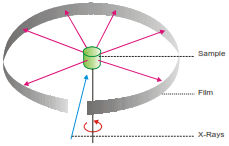Measurement of Diffraction Angle:
Rotating crystal method (Braggs, 1913)
Powder method (Debye and Scherrer, 1916)
Diffraction angle provides valuable information about the wave properties and the structure of the obstacle or aperture. The measurement of diffraction angle, θ, required for Bragg equation can be done in two ways.
1. Rotating Crystal Method (Braggs, 1913)
2. Powder Method (Debye and Scherrer, 1916)
Rotating Crystal Method
The apparatus used by Bragg is shown in figure below. A beam of X-rays of known wave length falls on a face of the crystal mounted on a graduated turn table. The diffracted rays pass into the ionisation chamber of the recorder. Here they ionise the air and a current flows between the chamber wall and an electrode inserted in it which is connected to an electrometer. The electrometer reading is proportional to the intensity of X-rays. As the recorder along with the crystal is rotated, the angles of maximum intensity are noted on the scale. Thus values of θ for n = 1, 2, 3, etc. are used to calculate the distance d between the lattice planes parallel to the face of the crystal.

Powder Method (Debye and Scherrer Method)
The rotating crystal method could only be used if a single undistorted crystal is available .To overcome this limitation, the powder method was devised. In this method the crystalline material contained in a capillary tube is placed in the camera containing a film strip shown below. The sample is rotated by means of a motor. The X-rays pass through the gap between the ends of the film.

The powdered sample contains small crystals arranged in all orientations. Some of these will reflect X-rays from each lattice plane at the same time. The reflected X-rays will make an angle 2θ with the original direction. Hence on the photo are obtained lines of constant θ. From the geometry of the camera, θ can be calculated for different crystal planes.

